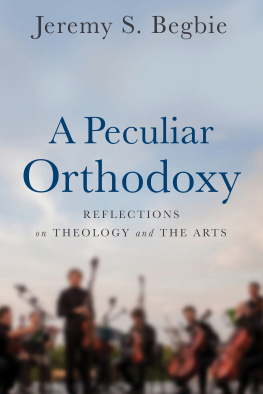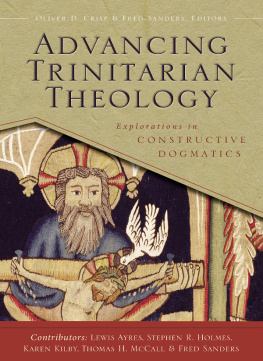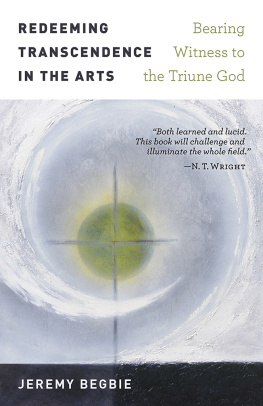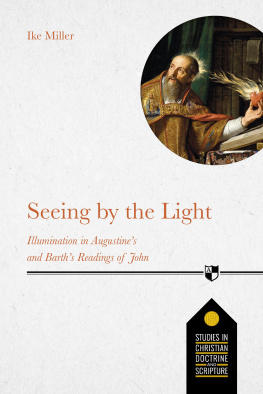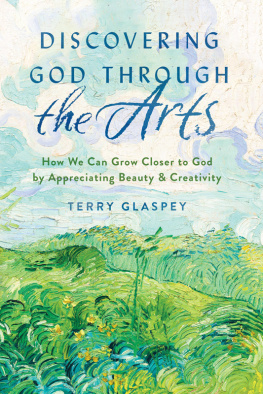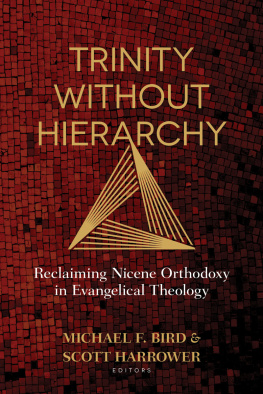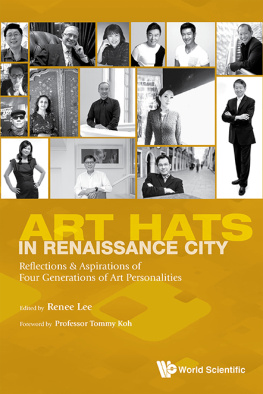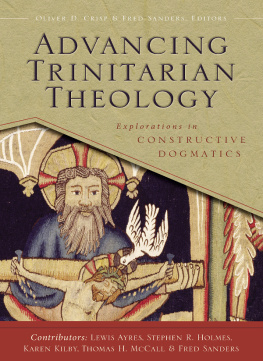Jeremy S. Begbie - A Peculiar Orthodoxy: Reflections on Theology and the Arts
Here you can read online Jeremy S. Begbie - A Peculiar Orthodoxy: Reflections on Theology and the Arts full text of the book (entire story) in english for free. Download pdf and epub, get meaning, cover and reviews about this ebook. year: 2018, publisher: Baker Publishing Group, genre: Religion. Description of the work, (preface) as well as reviews are available. Best literature library LitArk.com created for fans of good reading and offers a wide selection of genres:
Romance novel
Science fiction
Adventure
Detective
Science
History
Home and family
Prose
Art
Politics
Computer
Non-fiction
Religion
Business
Children
Humor
Choose a favorite category and find really read worthwhile books. Enjoy immersion in the world of imagination, feel the emotions of the characters or learn something new for yourself, make an fascinating discovery.
- Book:A Peculiar Orthodoxy: Reflections on Theology and the Arts
- Author:
- Publisher:Baker Publishing Group
- Genre:
- Year:2018
- Rating:4 / 5
- Favourites:Add to favourites
- Your mark:
- 80
- 1
- 2
- 3
- 4
- 5
A Peculiar Orthodoxy: Reflections on Theology and the Arts: summary, description and annotation
We offer to read an annotation, description, summary or preface (depends on what the author of the book "A Peculiar Orthodoxy: Reflections on Theology and the Arts" wrote himself). If you haven't found the necessary information about the book — write in the comments, we will try to find it.
A Peculiar Orthodoxy: Reflections on Theology and the Arts — read online for free the complete book (whole text) full work
Below is the text of the book, divided by pages. System saving the place of the last page read, allows you to conveniently read the book "A Peculiar Orthodoxy: Reflections on Theology and the Arts" online for free, without having to search again every time where you left off. Put a bookmark, and you can go to the page where you finished reading at any time.
Font size:
Interval:
Bookmark:
2018 by Jeremy S. Begbie
Published by Baker Academic
a division of Baker Publishing Group
PO Box 6287, Grand Rapids, MI 49516-6287
www.bakeracademic.com
Ebook edition created 2018
All rights reserved. No part of this publication may be reproduced, stored in a retrieval system, or transmitted in any form or by any meansfor example, electronic, photocopy, recordingwithout the prior written permission of the publisher. The only exception is brief quotations in printed reviews.
Library of Congress Cataloging-in-Publication Data is on file at the Library of Congress, Washington, DC.
ISBN 978-1-4934-1452-9
Scripture quotations are from the New Revised Standard Version of the Bible, copyright 1989, by the Division of Christian Education of the National Council of the Churches of Christ in the United States of America. Used by permission. All rights reserved.
In memory of Roger Lundin,
scholar, friend, and teacher extraordinaire

Cover
Title Page
Copyright Page
Dedication
Introduction
1. Created Beauty: The Witness of J. S. Bach
2. Beauty, Sentimentality, and the Arts
3. Faithful Feelings: Music and Emotion in Worship
4. Openness and Specificity: A Conversation with David Brown on Theology and Classical Music
5. Confidence and Anxiety in Elgars The Dream of Gerontius
6. The Holy Spirit at Work in the Arts: Learning from George Herbert
7. Natural Theology and Music
8. Room of Ones Own? Music, Space, and Freedom
9. The Future of Theology amid the Arts: Some Reformed Reflections
Index
Back Cover
One of the more encouraging signs in theological writing over the last thirty years or so has been a flourishing of activity at the interface of theology and the arts. When I first began working at this frontier in the early 1980s, although it was not hard to find material on poetry, music, and painting with overtly Christian subject matter, in many theological quarters that was about as far as the interest went. A few philosophically minded writers went out of their way to show how a Christian perception of the world might shape and in turn be shaped by our engagement with the arts. But this kind of activity tended to be confined to relatively small and isolated pockets. The majority of theologians in the United States and Europe tended to see the arts as a peripheral and specialist interest. There was little cross-disciplinary conversation, little recognition that the arts presented serious and fruitful territory for theological research, little in the way of college courses and programs, and very little of theological depth to help Christian laypeople come to terms with whatever art surrounded them day by day. And the resources for Christians who were making art on the groundmolding clay, stringing notes together, spinning words into versewere scarce.
Things are dramatically different today. College courses abound, institutes and doctoral programs flourish, parachurch organizations prosper, and literature pours out in myriad forms: monographs, journals, magazines, websites, and social media. Admittedly, funding to support the best of this activity is often meager, but there can be little doubt that, like the confluence of two rivers, Christian theology and the arts are together generating a bubbling ferment that shows no signs of abating. And much of this spans a wide ecclesiastical spectrumProtestant, Roman Catholic, Eastern Orthodoxgenerating cross-traditional conversation of a kind not witnessed to date. Here we should not forget the dogged persistence of those who over many decades have kept the arts firmly on the radar of church and academy, amid what was often a climate of indifference (in some cases hostility). To the likes of Nicholas Wolterstorff, Calvin Seerveld, Jane and John Dillenberger, Wilson Yates, Frank Burch Brown, Sandra Bowden, Richard Viladesau, Greg Wolfe, Mako Fujimura, William Dyrness, and others, we owe an incalculable debt.
This burgeoning activity is surely in large part to be welcomed, auguring well for the future health of both theology and the arts. If I had reservations about the present-day scene, they would not concern the liveliness of the field or its seriousness or depth. My misgivings would rather involve the theological resources being drawn upon. I welcome the sheer range and variety of ecclesial traditions currently being deployed, but what often seems to be lacking is the sustained exercise of what some have called a scriptural imaginationa sustained immersion in biblical texts that enables us to perceive and live in the world in a way that is faithful to Scriptures theological coherence, and this together with an attention to the classic creedal traditions that seek to convey and foster such an imagination. The reasons for this lack are many and varied. Undoubtedly one of them is that the Bibles overt references to the arts are few and far between, and the early churchs patterns of belief were established with relatively little sustained reflection on the arts. In this light it is hardly surprising that many have turned to extrabiblical and extracreedal sources for the most promising primary sources of theological wisdoman ancient metaphysical tradition perhaps, or a particular strand of modern or late modern philosophy. Others may put their confidence in a contemporary cultural movement or expression. Indeed, the tables can be turned here: some writers tell us that the arts themselves deliver theological wisdom that will make us question key elements in the biblical orthodoxy of yesteryear. The artist is typically an awkward customer, goading pastor and professor with questions they would rather ignore, questions that may well strike at the root of the faith once delivered.
While fully appreciating the motivations and concerns underlying these convictions, I have come to believe that the most profoundly awkward and in the long run most life-giving questions that arise from a Christian engagement with the arts will be provoked through engaging the often strange and puzzling texts the church recognizes as its canon and from the creedal confessions that seek to be faithful to its testimony. It is this stubborn peculiarity of biblically based orthodoxycentering on the embodiment of the worlds Creator in a crucified king, and a God who is perplexingly threefoldthat seems to be all too easily screened out or sanitized by those exploring the resonances between faith and the arts today. And it is worth emphasizing that in using peculiar in my title I have in mind both a strangeness (he had a peculiar look in his eye) and a distinctiveness (she had that look peculiar to academics). That is, I am keen to encourage an awareness not only of the odd and puzzling character of orthodoxy but also of how unique and unparalleled it is, and thus also an awareness of the danger both of muting its witness and of trying to turn it into something it is not.
Orthodoxy, of course, necessarily deals with doctrine, and like orthodoxy, talk of doctrine may well raise hackles. Doctrine, it will be protested, is about tidying things up, things that need to be left open. In the churchs deadening passion for control and conformity, for accurate propositions that supposedly give us a final hold on truth, mystery is dissolved, open-minded inquiry suppressed, conversation closed down. The arts move in a radically different world, so we are told, breathing a much fresher and healthier air. Here we will find openness, allusiveness, ambiguity, a resistance to that stifling pursuit of certainty that has plagued so much of the churchs history. Indeed, at their best, the arts can help liberate the church from its misguided reliance on doctrinal correctness.
Font size:
Interval:
Bookmark:
Similar books «A Peculiar Orthodoxy: Reflections on Theology and the Arts»
Look at similar books to A Peculiar Orthodoxy: Reflections on Theology and the Arts. We have selected literature similar in name and meaning in the hope of providing readers with more options to find new, interesting, not yet read works.
Discussion, reviews of the book A Peculiar Orthodoxy: Reflections on Theology and the Arts and just readers' own opinions. Leave your comments, write what you think about the work, its meaning or the main characters. Specify what exactly you liked and what you didn't like, and why you think so.

